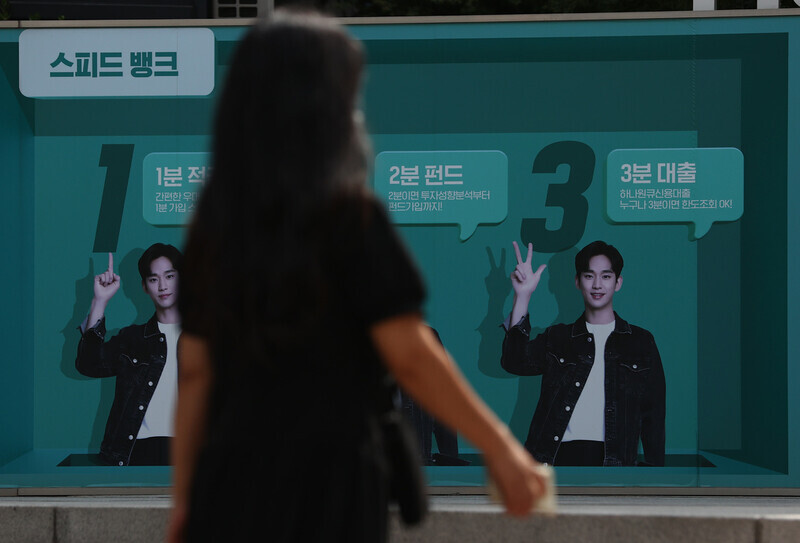hankyoreh
Links to other country sites 다른 나라 사이트 링크
S. Korea’s total household debt reaches new high at $1.54 trillion

South Korea’s total household debt balance topped 1.8 quadrillion won (US$1.54 trillion) for the first time during the second quarter of 2021, increasing by a quarterly high of 41.2 trillion won (US$35.2 billion), according to the Bank of Korea (BOK) on Tuesday.
The rise was the result of an unabated trend of households incurring debt for public offering subscriptions and other investments amid continued demand for housing transactions. Observers are now watching to see whether government efforts to beef up loan regulations and raise the benchmark interest rate will have an effect in checking the increase in loans during the second half of the year.
It was the highest-ever increase for a second quarter, propelling the total balance past 1.8 quadrillion won. Household credit — which could also be characterized as household debt — represents the sum of household loans combined with sales on credit, including credit card use.
As of the end of Q2 2021, the balance of household loans was 1.7053 quadrillion won (US$1.45 trillion), up by 38.6 trillion won (US$33 billion) from the previous quarter. This too was the highest increase yet recorded for a second quarter.
Mortgage loans increased by 17.3 trillion won (US$14.8 billion), representing a slight drop-off from an increase of 20.4 trillion won (US$17.4 billion) the preceding quarter.
But the increase in other loans — mostly lines of credit and other forms of credit loans — totaled 21.3 trillion won (US$18.2 billion), surpassing the 14.3 trillion won (US$12.2 billion) recorded in the first quarter. The numbers suggest that the boom in public offering subscriptions during the first half of the year has impacted the rise in other forms of loans.
“With household loans during the second quarter, there was a sustained demand for residential transaction funds despite increased regulations by financial authorities, along with demand for loans for public offering subscriptions and money for people to live on amid the COVID-19 pandemic’s spread,” said Song Jae-chang, director of the BOK financial statistics team.
Bank loans decreased in the second quarter, while loans from non-banking and other financial institutions increased.
During Q2 2021, bank loans increased by 12.4 trillion won (US$10.6 billion), down from an increase of 18.7 trillion won (US$16 billion) during the first quarter. Mortgage loans were down, while other loans were up.
Loans from mutual finance institutions, credit unions, and other non-bank depository institutions increased by 9.1 trillion won (US$7.79 billion) during the second quarter, far exceeding the rise of 5.6 trillion won (US$4.79 billion) during the first quarter. The increase in mortgage loans was similar to the preceding quarter, while the increase in other loans grew.
Loans from insurance and securities companies and other forms of financial institutions increased by 17.1 trillion won (US$14.6 billion), compared with a rise of 10.5 trillion won (US$8.98 billion) during the first quarter.
During Q2 2021, the balance of sales on credit reached 100.6 trillion won (US$86.1 billion) amid a recovery in consumption sentiment to levels seen before the fourth COVID-19 wave. The level was 2.7 trillion won (US$2.31 billion) higher than in the previous quarter — also an all-time high increase for a second quarter.
With household debt increasing sharply during the second quarter despite the government’s warnings, many are watching to see how things develop in the second half of the year. Financial authorities have recently been beefing up loan regulations, and an interest rate hike within the year is emerging as a real possibility.
“The rate of increase in household credit could be blunted if the benchmark interest rate is hiked, causing interest on loans to increase,” Song Jae-chang said.
“In addition to interest rate policies, the financial institutions’ attitudes on household loans also have an influence on household credit, so we’ll need to keep watching the policy response trends going forward,” he added.
By Jun Seul-gi, staff reporter
Please direct comments or questions to [english@hani.co.kr]

Editorial・opinion
![[Editorial] Yoon must halt procurement of SM-3 interceptor missiles [Editorial] Yoon must halt procurement of SM-3 interceptor missiles](https://flexible.img.hani.co.kr/flexible/normal/500/300/imgdb/child/2024/0501/17145495551605_1717145495195344.jpg) [Editorial] Yoon must halt procurement of SM-3 interceptor missiles
[Editorial] Yoon must halt procurement of SM-3 interceptor missiles![[Guest essay] Maybe Korea’s rapid population decline is an opportunity, not a crisis [Guest essay] Maybe Korea’s rapid population decline is an opportunity, not a crisis](https://flexible.img.hani.co.kr/flexible/normal/500/300/imgdb/original/2024/0430/9417144634983596.jpg) [Guest essay] Maybe Korea’s rapid population decline is an opportunity, not a crisis
[Guest essay] Maybe Korea’s rapid population decline is an opportunity, not a crisis- [Column] Can Yoon steer diplomacy with Russia, China back on track?
- [Column] Season 2 of special prosecutor probe may be coming to Korea soon
- [Column] Park Geun-hye déjà vu in Yoon Suk-yeol
- [Editorial] New weight of N. Korea’s nuclear threats makes dialogue all the more urgent
- [Guest essay] The real reason Korea’s new right wants to dub Rhee a founding father
- [Column] ‘Choson’: Is it time we start referring to N. Korea in its own terms?
- [Editorial] Japan’s rewriting of history with Korea has gone too far
- [Column] The president’s questionable capacity for dialogue
Most viewed articles
- 1Months and months of overdue wages are pushing migrant workers in Korea into debt
- 2[Guest essay] Maybe Korea’s rapid population decline is an opportunity, not a crisis
- 3Dermatology, plastic surgery drove record medical tourism to Korea in 2023
- 4Under conservative chief, Korea’s TRC brands teenage wartime massacre victims as traitors
- 5At heart of West’s handwringing over Chinese ‘overcapacity,’ a battle to lead key future industries
- 6Trump asks why US would defend Korea, hints at hiking Seoul’s defense cost burden
- 7First meeting between Yoon, Lee in 2 years ends without compromise or agreement
- 81 in 3 S. Korean security experts support nuclear armament, CSIS finds
- 9[Editorial] Yoon must halt procurement of SM-3 interceptor missiles
- 10Fruitless Yoon-Lee summit inflames partisan tensions in Korea